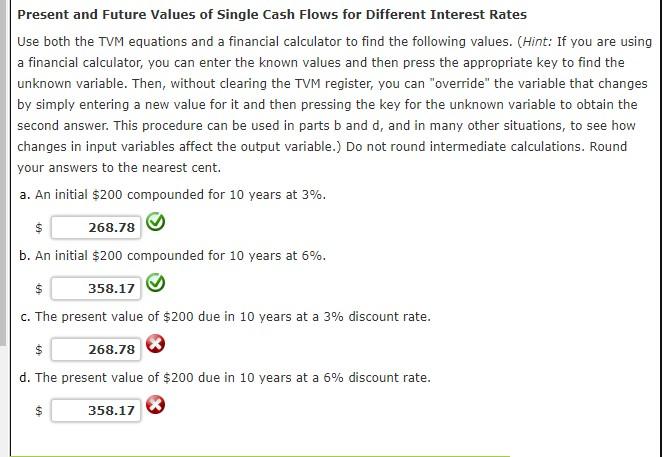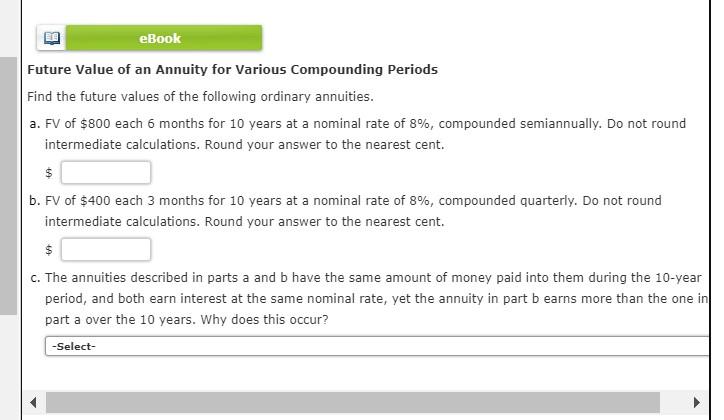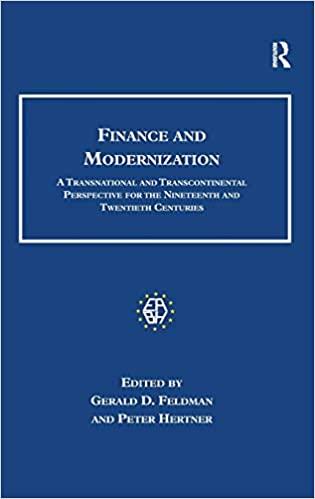Answered step by step
Verified Expert Solution
Question
1 Approved Answer
ONLY COMPLETE IF ANSWERING ALL. DO NOT COMPLETE IF NOT ANSWERING ALL!!! Present and Future Values of Single Cash Flows for Different Periods Find the
ONLY COMPLETE IF ANSWERING ALL. DO NOT COMPLETE IF NOT ANSWERING ALL!!!





Present and Future Values of Single Cash Flows for Different Periods Find the following values, using the equations, and then work the problems using a financial calculator to check your answers. Disregard rounding differences. (Hint: If you are using a financial calculator, you can enter the known values and then press the appropriate key to find the unknown variable. Then, without clearing the TVM register, you can "override" the variable that changes by simply entering a new value for it and then pressing the key for the unknown variable to obtain the second answer. This procedure can be used in parts b and d, and in many other situations, to see how changes in input variables affect the output variable.) Do not round intermediate calculations. Round your answers to the nearest cent. a. An initial $600 compounded for 1 year at 5.5%. b. An initial $600 compounded for 2 years at 5.5%. $ c. The present value of $600 due in 1 year at a discount rate of 5.5%. $ d. The present value of $600 due in 2 years at a discount rate of 5.5%. Present and Future Values of Single Cash Flows for Different Interest Rates Use both the TVM equations and a financial calculator to find the following values. (Hint: If you are using a financial calculator, you can enter the known values and then press the appropriate key to find the unknown variable. Then, without clearing the TVM register, you can "override" the variable that changes by simply entering a new value for it and then pressing the key for the unknown variable to obtain the second answer. This procedure can be used in parts b and d, and in many other situations, to see how changes in input variables affect the output variable.) Do not round intermediate calculations. Round your answers to the nearest cent. a. An initial $200 compounded for 10 years at 3%. $ b. An initial $200 compounded for 10 years at 6%. 5 c. The present value of $200 due in 10 years at a 3% discount rate. $ d. The present value of $200 due in 10 years at a 6% discount rate. $ a. Find the present values of the following cash flow streams. The appropriate interest rate is 11%. (Hint: It is fairly easy to work this problem dealing with the individual cash flows. However, if you have a financial calculator, read the section of the manual that describes how to enter cash flows such as the ones in this problem. This will take a little time, but the investment will pay huge dividends throughout the course. Note that, when working with the calculator's cash flow register, you must enter CF0=0. Note also that it is quite easy to work the problem with Excel, using procedures described in the Ch04 Tool Kit.xIsx.) Do not round intermediate calculations. Round your answers to the nearest cent. Stream A: $ Stream B: $ b. What is the value of each cash flow stream at a 0% interest rate? Round your answers to the nearest dollar. Stream A \$ Stream B \$ Future Value for Various Compounding Periods Find the amount to which $475 will grow under each of the following conditions. Do not round intermediate calculations. Round your answers to the nearest cent. a. 12% compounded annually for 5 years. $ b. 12% compounded semiannually for 5 years. $ c. 12% compounded quarterly for 5 years. $ d. 12% compounded monthly for 5 years. $ Future Value of an Annuity for Various Compounding Periods Find the future values of the following ordinary annuities. a. FV of $800 each 6 months for 10 years at a nominal rate of 8%, compounded semiannually. Do not round intermediate calculations. Round your answer to the nearest cent. $ b. FV of $400 each 3 months for 10 years at a nominal rate of 8%, compounded quarterly. Do not round intermediate calculations. Round your answer to the nearest cent. $ c. The annuities described in parts a and b have the same amount of money paid into them during the 10 -year period, and both earn interest at the same nominal rate, yet the annuity in part b earns more than the one in part a over the 10 years. Why does this occur
Step by Step Solution
There are 3 Steps involved in it
Step: 1

Get Instant Access to Expert-Tailored Solutions
See step-by-step solutions with expert insights and AI powered tools for academic success
Step: 2

Step: 3

Ace Your Homework with AI
Get the answers you need in no time with our AI-driven, step-by-step assistance
Get Started


